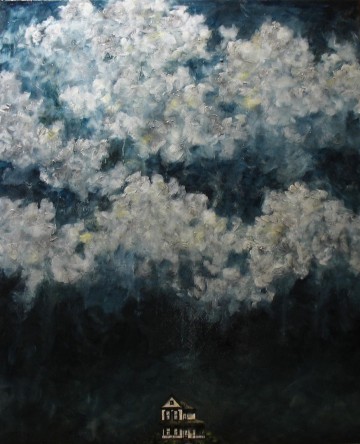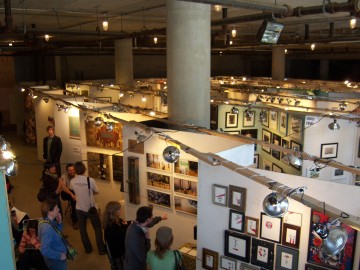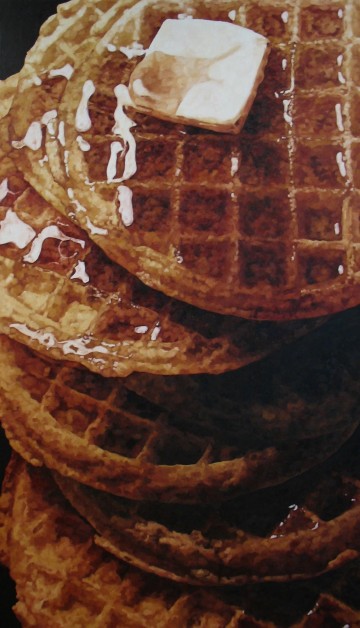
Pamela Johnson, "House II," 2006. Oil on canvas, 44 x 36 in. Courtesy the artist.
Sometime in September of 2006, I came across the paintings of Pamela Michelle Johnson, vaguely oppressive canvases dominated by clouds of slate and steel gray, foregrounds indistinguishable from back, and expanses of heavy color upon which occasionally sat detailed tiny houses or which crawled white-knuckled women in a tensed-muscle distress of indeterminate origin, their heads turned down and eyes unseen.
Aside from striking me as beautifully thick with paint in the way of Gerhard Richter’s abstracts, I just didn’t connect with the work, couldn’t wrap my fingers around the images or project my own little world into them. They intrigued me and started me wondering about Johnson’s history, but I found the paintings inaccessible overall. I could stare at length at where colors touched and pressed themselves into other colors, but I couldn’t read their stories. In hindsight, it could be that the averted faces and cloud cover created an impenetrable wall, or that whatever those taut bodies were crawling away from somehow intimidated me or struck a chord I wasn’t ready or able to consider.
Pamela Johnson I connected with, however. She’s self-effacing and quietly eloquent in a way that made me realize she’s a lot smarter than me. Based on the quality of her painting, I was surprised to learn that she not so long ago had an entirely different profession. “I was an engineer until 2003, working on the construction side for Webcor Builders,” a full-service general contractor which has erected many of California’s important and environmentally responsible structures since 1971. She graduated from California Polytechnic with a B.S. in Civil Engineering and a minor with honors in art. While working as an engineer, Johnson was awarded a three-month residency at The Institute of Ceramic Studies in Shigaraki, Japan, which she said was “an amazing experience that came at a crazy hard time in my life.” She credits this period with being instrumental in changing her focus from engineering to art, which ultimately led her from San Francisco to Chicago.
Johnson was one of many artists I met during the first few shows I participated in, along with sometimes hundreds of painters, illustrators, sculptors, photographers and performers at an arts festival anchored by Around the Coyote Gallery, a Chicago hub for emerging artists and general enlightenment which, sadly, no longer exists. The gallery that is, not general enlightenment, though we could debate.

The southeast corner of Around the Coyote's spring festival, 2008. Courtesy of Shélan O'Keefe.
When you’re showing with that many people, there is absolutely no chance that you’ll like everything you see, so you pick your favorite works of art and you talk to the artists who made them. That’s how you start, at least. Soon enough, the conversation grows as other artists wander over, and you get to know them and learn how fascinating they are. By the end you know everyone, and even if someone’s art doesn’t speak to you, particular individuals possess that incredible spark which insists that if you keep your eyes optimistically pointed their way in full faith that they will eventually create something to knock you off your feet.
This is exactly what happened when Pamela Johnson took an entirely different direction with a new series called American Still Life – a ravishing body of work rendering our dietary habits larger than life – in which the artist so virtuously achieved her goal that I was stunned when I first saw the work in person; few and far between are the occasions that I’ve been able to see such potent shifts in subject matter or eloquent turns in an artist’s trajectory, so when those occasions arise, I’m happy to be there and I like to take note and gush to anyone who will listen.

Pamela Johnson, "Waffles," 2007. Oil on canvas, 72 x 42 in. Courtesy the artist.
Six-foot tall canvases of syrup-drenched stacks of waffles on whose melting butter the light plays vividly, so richly sticky sweet looking that you feel full just gazing at the golden glow; mammoth stacks of gross ketchup-stained hamburgers leaning with the threat of not only satiating a chemically modified factory-farmed hunger bordering on addiction, but to crush you under the sheer weight of their meaty mass. Hostess cupcakes with sublimely glistening whipped lard in the center of moist chocolate cake, atop which sits that strange waxy layer of frosting decorated by a plastic-ish braid of white; slices of pink floret-topped wedding cake big enough to bend the pews of Holy Name Cathedral and rich enough to finance a collection of jewel-encrusted skulls; donuts and sugar cookies and danishes that literally make your mouth water and gut ache.
From her artist statement:
Devouring to the point where we are left with nothing, nothing but the consequential garbage. Quintessentially American, junk food is not just part of our diet, it epitomizes our cultural ideals and social norms. Through my work, I strive to invoke reflection on a culture focused on mass-consumption and mass-production, where the negative aspects of overindulgence are often forgotten or ignored. The work questions a culture that equates fulfillment, pleasure, and happiness with what we consume.
The paintings kicked my ass, in part because they came from the same person who entered Chicago’s art scene with houses and women buried beneath ominous skies (undoubtedly, a similar dread exists in the junk food paintings, but it’s a dread I am more apt to sink my teeth into, so to speak), but even more so because these paintings took me somewhere.



